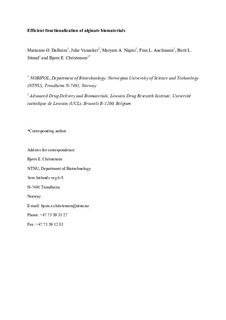| dc.contributor.author | Dalheim, Marianne Øksnes | |
| dc.contributor.author | Vanacker, Julie | |
| dc.contributor.author | Najmi, Maryam A. | |
| dc.contributor.author | Aachmann, Finn Lillelund | |
| dc.contributor.author | Strand, Berit Løkensgard | |
| dc.contributor.author | Christensen, Bjørn E. | |
| dc.date.accessioned | 2017-10-30T12:05:33Z | |
| dc.date.available | 2017-10-30T12:05:33Z | |
| dc.date.created | 2015-12-18T08:17:24Z | |
| dc.date.issued | 2016 | |
| dc.identifier.citation | Biomaterials. 2016, 80 146-156. | nb_NO |
| dc.identifier.issn | 0142-9612 | |
| dc.identifier.uri | http://hdl.handle.net/11250/2462862 | |
| dc.description.abstract | Peptide coupled alginates obtained by chemical functionalization of alginates are commonly used as scaffold materials for cells in regenerative medicine and tissue engineering. We here present an alternative to the commonly used carbodiimide chemistry, using partial periodate oxidation followed by reductive amination. High and precise degrees of substitution were obtained with high reproducibility, and without formation of by-products. A protocol was established using l-Tyrosine methyl ester as a model compound and the non-toxic pic-BH3 as the reducing agent. DOSY was used to indirectly verify covalent binding and the structure of the product was further elucidated using NMR spectroscopy. The coupling efficiency was to some extent dependent on alginate composition, being most efficient on mannuronan. Three different bioactive peptide sequences (GRGDYP, GRGDSP and KHIFSDDSSE) were coupled to 8% periodate oxidized alginate resulting in degrees of substitution between 3.9 and 6.9%. Cell adhesion studies of mouse myoblasts (C2C12) and human dental stem cells (RP89) to gels containing various amounts of GRGDSP coupled alginate demonstrated the bioactivity of the material where RP89 cells needed higher peptide concentrations to adhere. | nb_NO |
| dc.language.iso | eng | nb_NO |
| dc.publisher | Elsevier | nb_NO |
| dc.rights | Attribution-NonCommercial-NoDerivatives 4.0 Internasjonal | * |
| dc.rights.uri | http://creativecommons.org/licenses/by-nc-nd/4.0/deed.no | * |
| dc.title | Efficient functionalization of alginate biomaterials | nb_NO |
| dc.type | Journal article | nb_NO |
| dc.type | Peer reviewed | nb_NO |
| dc.description.version | acceptedVersion | nb_NO |
| dc.source.pagenumber | 146-156 | nb_NO |
| dc.source.volume | 80 | nb_NO |
| dc.source.journal | Biomaterials | nb_NO |
| dc.identifier.doi | 10.1016/j.biomaterials.2015.11.043 | |
| dc.identifier.cristin | 1302369 | |
| dc.relation.project | Norges forskningsråd: 221576 | nb_NO |
| dc.description.localcode | © 2015. This is the authors’ accepted and refereed manuscript to the article. LOCKED until 2.12.2017 due to copyright restrictions. This manuscript version is made available under the CC-BY-NC-ND 4.0 license http://creativecommons.org/licenses/by-nc-nd/4.0/ | nb_NO |
| cristin.unitcode | 194,66,15,0 | |
| cristin.unitname | Institutt for bioteknologi og matvitenskap | |
| cristin.ispublished | true | |
| cristin.fulltext | postprint | |
| cristin.qualitycode | 2 | |

